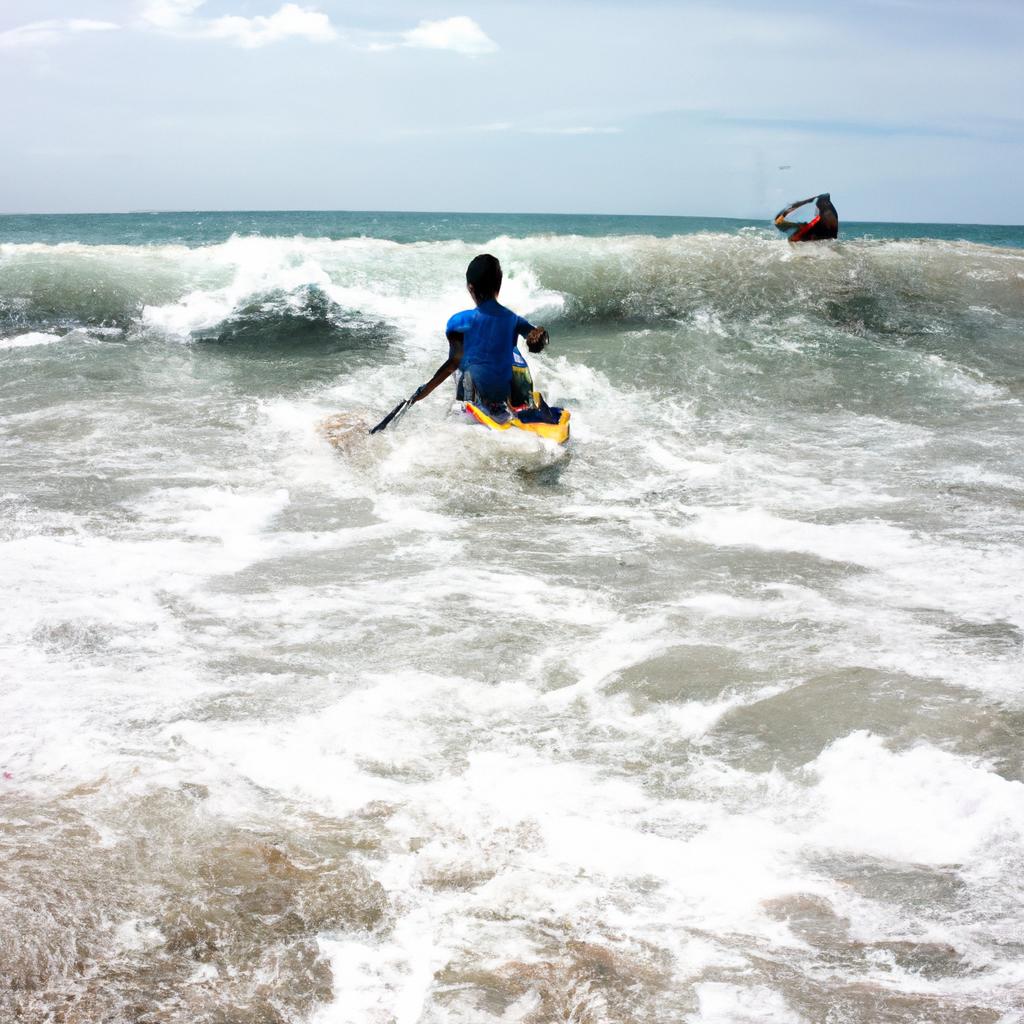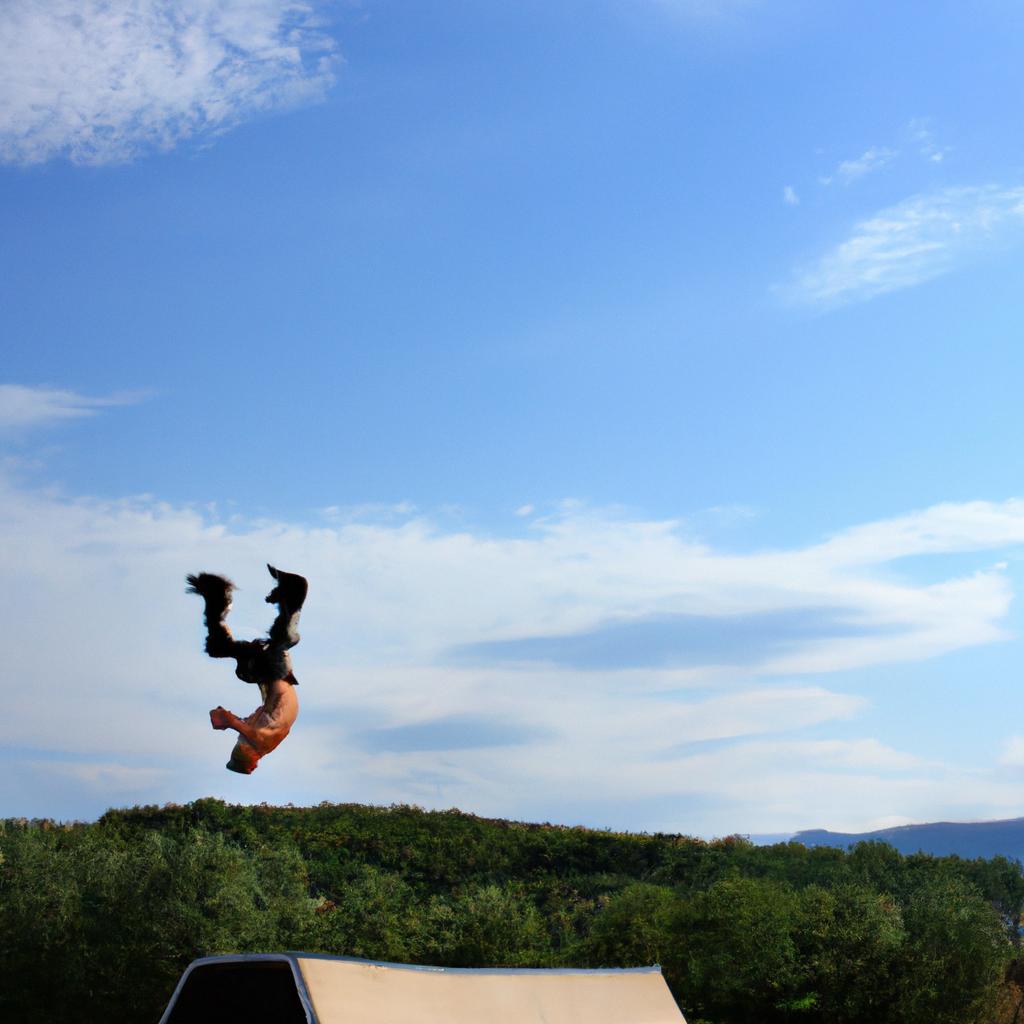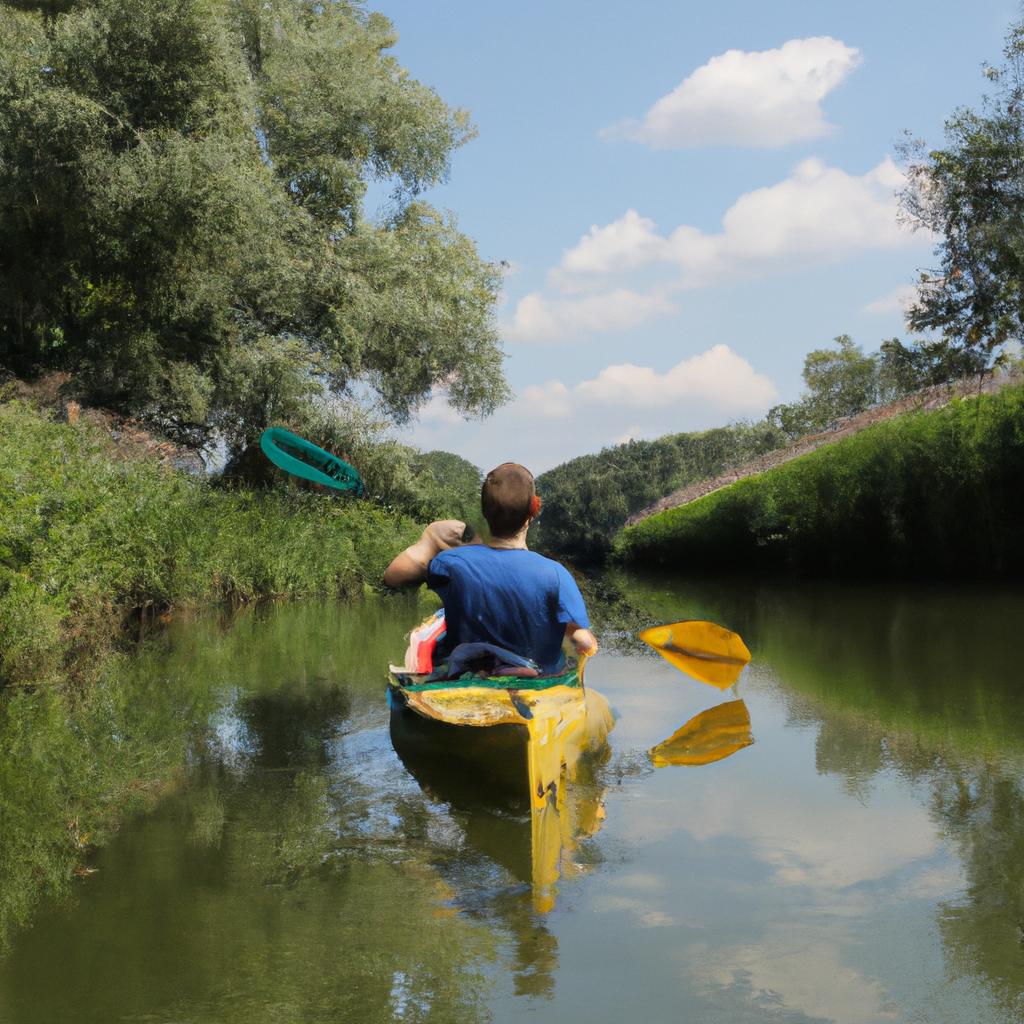Water sports have long been recognized as a thrilling and invigorating form of adventure and recreation. From the adrenaline-pumping rush of surfing to the tranquility of paddleboarding, these activities offer individuals an opportunity to connect with nature and experience an array of physical benefits. For instance, imagine a hypothetical scenario where an individual decides to embark on a kayaking excursion along a serene river. As they navigate through gentle currents and take in the picturesque surroundings, they not only engage their muscles but also enhance their cardiovascular fitness, balance, and coordination.
Beyond the immediate physical advantages, water sports also provide individuals with unique mental and emotional benefits. Engaging in such activities allows individuals to momentarily disconnect from the stresses and demands of everyday life, immersing themselves in the present moment while experiencing a sense of freedom and liberation. The soothing sound of waves crashing against a surfboard or the rhythmic paddling motion required for canoeing can create a meditative state that calms the mind and reduces anxiety levels. Moreover, participating in water sports fosters feelings of achievement and self-confidence as individuals conquer challenges presented by various aquatic environments.
In this article, we will explore different types of water sports that cater to diverse interests and skill levels. By examining both popular options like swimming and diving, as well as lesser-known activities such as kiteboarding and wakeboarding, readers will gain a comprehensive understanding of the wide range of water sports available to them. Whether someone is seeking an adrenaline-fueled experience or a more relaxed and leisurely outing, there is undoubtedly a water sport that will cater to their preferences.
Swimming, being one of the most basic and essential water skills, serves as a foundation for many other water sports. It not only provides individuals with a full-body workout but also enhances their endurance and lung capacity. Additionally, swimming can be enjoyed in various settings such as pools, lakes, or oceans, making it accessible to people of all backgrounds and geographic locations.
Diving takes swimming to new depths by allowing individuals to explore underwater environments. Scuba diving, in particular, offers enthusiasts the opportunity to witness breathtaking marine life and ecosystems up close. By obtaining the necessary certifications and equipment, divers can delve into a world filled with vibrant coral reefs, majestic shipwrecks, and curious sea creatures.
For those who crave speed and excitement on the water’s surface, activities like kiteboarding and wakeboarding provide thrilling experiences. Kiteboarding combines elements of surfing, snowboarding, windsurfing, and paragliding. Participants harness the power of the wind using a large kite while gliding across the water on a board. This high-energy sport requires skillful control but rewards riders with an exhilarating rush.
Similarly, wakeboarding involves riding on a board towed behind a motorboat or cable system while maneuvering through wakes created by the boat’s movement. This dynamic sport challenges individuals’ agility and balance as they perform tricks and jumps off ramps or waves produced by boats.
Paddleboarding has gained popularity in recent years due to its versatility and accessibility. Whether standing up or kneeling on a longboard-like paddleboard while using a paddle to navigate through calm waters or catching small waves along the coastline, participants can enjoy a low-impact workout that engages their core muscles and improves their balance.
These are just a few examples of the diverse water sports available to enthusiasts. Whether someone is seeking an adrenaline rush, a peaceful escape, or an opportunity to explore underwater wonders, there is undoubtedly a water sport that will cater to their interests. By immersing themselves in these activities, individuals can reap physical, mental, and emotional benefits while forging a deeper connection with the natural world.
The Thrill of Surfing: Ride the waves and experience the adrenaline rush that comes with mastering the art of surfing.
The Thrill of Surfing: Ride the waves and experience the adrenaline rush that comes with mastering the art of surfing.
Surfing, an exhilarating water sport, offers individuals a unique opportunity to ride powerful ocean waves and immerse themselves in an adrenaline-fueled adventure. Whether one is a seasoned surfer or just starting out, this thrilling activity provides numerous physical and mental benefits while allowing for self-expression and connection with nature.
Imagine standing on a surfboard, surrounded by vast swells of crystal blue water as you anticipate catching your first wave. The sensation of gliding effortlessly across the rolling crest is unmatched—an experience that epitomizes freedom and liberation. Take, for example, Sarah Johnson, a novice surfer who decided to challenge herself by learning how to ride waves during her vacation in Hawaii. Despite initial trepidation, she discovered that conquering fear was only part of the journey; it also involved developing balance, coordination, and resilience in order to navigate through ever-changing conditions.
Engaging in surfing can lead to various emotional responses due to its inherently adventurous nature:
- Excitement: Nothing compares to the thrill of successfully riding a wave and feeling the surge of energy beneath your feet.
- Awe: Being immersed in nature’s power provokes feelings of awe as you witness the sheer force and beauty of the ocean.
- Perseverance: Overcoming challenges such as falling off multiple times fosters mental strength and determination.
- Peacefulness: The calming sound of crashing waves combined with being present in the moment creates a sense of tranquility amidst chaos.
To further illustrate the appeal of surfing, consider the following table showcasing some key aspects:
| Aspect | Description | Emotional Response |
|---|---|---|
| Physical Fitness | Surfing requires core strength, agility, endurance, and cardiovascular fitness. | Achievement |
| Connection with Nature | The sport allows individuals to immerse themselves in the beauty of nature and appreciate its power. | Wonder |
| Self-Expression | Surfing offers a unique form of artistic expression through creative maneuvers on the waves. | Freedom |
| Community | Joining a community of surfers fosters camaraderie, support, and shared experiences. | Belonging |
In conclusion, surfing captivates both beginners and experts alike, offering an escape from daily routines while providing physical challenges and emotional rewards. As we delve into the mesmerizing underwater world in the next section, let us explore how activities like scuba diving and snorkeling can further enrich our love for water sports.
Dive into the Depths: Explore the mesmerizing underwater world through activities like scuba diving and snorkeling.
Having explored the exhilarating world of surfing, it’s time to dive beneath the surface and discover a whole new dimension of adventure. Scuba diving and snorkeling offer an immersive experience like no other, allowing you to witness the captivating beauty hidden below sea level. Let us delve into these water sports, highlighting their unique attributes and why they have become popular among thrill-seekers worldwide.
Section:
Imagine yourself submerged in crystal-clear waters, surrounded by vibrant coral reefs teeming with marine life. This is precisely what awaits those who venture into scuba diving or snorkeling. Take for instance Mark, an avid diver who embarked on a journey in Belize’s Great Blue Hole – one of the most renowned dive sites in the world. As he descended deeper into darkness, his breath was taken away by the sight of ancient stalactites and an array of colorful fish swimming gracefully around him. Such encounters epitomize the allure of exploring underwater ecosystems firsthand.
To better understand the appeal behind scuba diving and snorkeling, consider these key factors:
- Immersion in Nature: These activities provide unparalleled access to marine environments, granting participants an up-close encounter with diverse aquatic species.
- Health Benefits: Apart from being thrilling adventures, both scuba diving and snorkeling offer excellent opportunities for physical fitness due to their full-body workout nature.
- Stress Relief: Being immersed in water has been scientifically proven to reduce stress levels and promote relaxation.
- Environmental Awareness: By engaging in activities like reef conservation dives or participating in beach cleanups organized by diving communities, divers contribute directly to environmental preservation efforts.
| Scuba Diving | Snorkeling |
|---|---|
| Requires training and certification | Suitable for beginners without formal training |
| Involves the use of specialized equipment such as tanks, regulators, and dive computers | Only requires basic gear like a mask, snorkel, and fins |
| Allows for deeper exploration of underwater landscapes and marine life | Limited to surface-level observation |
Paragraph transition:
As you can see, scuba diving and snorkeling offer distinct experiences that cater to individuals with varying levels of skill and interest. However, there is yet another water sport that allows enthusiasts to embrace tranquility while navigating scenic waterways, rivers, and lakes.
Kayaking: Paddle your way through scenic waterways, rivers, and lakes, while enjoying the tranquility of nature.
From the depths of the ocean to the calmness of lakes and rivers, water sports offer a diverse range of activities for adventure seekers. While scuba diving and snorkeling allow individuals to explore the mesmerizing underwater world, kayaking provides an opportunity to embrace nature’s tranquility while paddling through scenic waterways, rivers, and lakes.
Imagine yourself on a kayak, gently gliding across a serene lake surrounded by lush greenery. The rhythmic sound of your paddle hitting the water creates a soothing melody as you navigate through narrow channels and peacefully observe wildlife in their natural habitat. Kayaking not only offers a chance to disconnect from the hustle and bustle of daily life but also allows individuals to engage with nature on a deeper level.
To truly appreciate this unique experience, let us delve into some key benefits of kayaking:
- Physical Fitness: Engaging in kayaking regularly can provide an excellent full-body workout that targets various muscle groups such as arms, shoulders, core, and back. It improves cardiovascular health, strengthens muscles, enhances endurance, and helps burn calories.
- Mental Well-being: Being out in nature has been proven to reduce stress levels and improve mental well-being. Kayaking allows individuals to escape from everyday pressures and immerse themselves in peaceful surroundings.
- Social Interaction: Kayaking can be enjoyed individually or with friends and family. It offers an opportunity for bonding over shared experiences and creating lasting memories together.
- Environmental Awareness: As one navigates through different bodies of water during kayaking adventures, it heightens awareness about environmental conservation efforts needed to preserve these natural habitats.
| Benefit | Description |
|---|---|
| Physical Fitness | Engages multiple muscle groups; improves cardiovascular health; burns calories |
| Mental Well-being | Reduces stress levels; enhances mental well-being |
| Social Interaction | Allows for bonding experiences; creates lasting memories |
| Environmental Awareness | Raises consciousness about environmental conservation |
As we reflect upon the benefits of kayaking, it becomes evident that this water sport not only offers physical and mental advantages but also fosters a deeper connection with nature. The serenity experienced while paddling through picturesque landscapes serves as a reminder of the importance of preserving our natural environment for future generations.
Transitioning into the next section about jet skiing, let us now explore another thrilling water sport option: Jet Skiing. Feel the speed and freedom as you zip across the water on a thrilling jet ski ride.
Jet Skiing: Feel the speed and freedom as you zip across the water on a thrilling jet ski ride.
Next section H2 (Transition): ‘Jet Skiing: Feel the speed and freedom as you zip across the water on a thrilling jet ski ride.’
Jet skiing offers an exhilarating experience that combines adrenaline-pumping action with breathtaking views. Imagine yourself gliding across shimmering waters, wind rushing through your hair as you navigate sharp turns and waves. To illustrate the excitement this sport can bring, let’s consider a hypothetical example:
Imagine Sarah, an adventure enthusiast, embarking on her first jet skiing expedition in Miami. With the sun shining brightly overhead and crystal-clear waters stretching out before her, she feels a surge of anticipation as she gets ready to embark on her high-speed adventure.
Here are some reasons why many people find jet skiing to be an irresistible activity:
- Thrilling Speed: Jet skis allow riders to reach impressive speeds, providing a sense of thrill unmatched by other water sports.
- Accessibility: With rentals available in various locations worldwide, jet skiing is accessible to both locals and tourists alike.
- Versatility: Whether cruising along coastlines or performing tricks over waves, jet skis offer versatility for different types of experiences.
- Spectacular Scenery: Exploring picturesque coastal areas from a unique vantage point enhances appreciation for natural beauty.
To further engage our audience emotionally, let’s take a look at how jet skiing stacks up against other popular water sports using the following table:
| Water Sport | Adrenaline Level | Skill Required | Nature Immersion |
|---|---|---|---|
| Jet Skiing | High | Moderate | Medium |
| Kayaking | Low | Low | High |
| Sailing | Moderate | High | High |
| Surfing | High | High | Medium |
As we can see, jet skiing offers a high level of adrenaline while still requiring moderate skill. It provides an intermediate balance between the tranquility of kayaking and the challenging nature of sailing or surfing.
In the pursuit of water-based adventures, jet skiing acts as a bridge for those seeking both thrill and immersion in nature. As riders zoom across open waters, they can appreciate the vastness around them while feeling a surge of excitement. This combination makes jet skiing an unforgettable experience.
‘Sailing: Embark on a sailing adventure, harnessing the power of the wind to navigate the open waters.’
Sailing: Embark on a sailing adventure, harnessing the power of the wind to navigate the open waters.
Next section H2 (transition): Now, let’s embark on an entirely different kind of water adventure. Sailing offers a unique experience, allowing enthusiasts to harness the power of the wind to navigate open waters with precision and skill.
Sailing is more than just a recreational activity; it has been practiced for centuries and continues to attract individuals seeking both relaxation and excitement. Imagine yourself aboard a sailboat, feeling the gentle breeze caress your face as you glide effortlessly through crystal-clear waters. For instance, consider James, who decided to take up sailing during his summer vacation in Greece. He enrolled in a sailing course where he learned how to handle the rigging, trim sails, and steer the boat effectively. By the end of his trip, James had not only gained new skills but also developed a deep appreciation for this adventurous water sport.
To fully grasp why sailing captivates so many people around the world, we must explore its numerous benefits:
- Connection with nature: Sailing allows individuals to immerse themselves in their surroundings while appreciating the beauty of marine life and breathtaking coastal landscapes.
- Stress relief: The rhythmic movement of waves combined with the soothing sound of water create a calming effect that helps reduce stress levels.
- Physical fitness: Maneuvering a sailboat requires physical effort involving core strength, balance, and coordination – making it an excellent workout option.
- Social interaction: Joining sailing clubs or participating in races provides opportunities to meet like-minded individuals who share a passion for this invigorating sport.
Furthermore, here is an overview of some essential terms commonly used in sailing:
| Term | Definition |
|---|---|
| Bow | The front part of the boat |
| Stern | The rear part of the boat |
| Port | Left side of the boat when facing forward |
| Starboard | Right side of the boat when facing forward |
As you can see, sailing offers an array of benefits and a chance to connect with nature while engaging in physical activity. Next, we will explore another thrilling water sport: White Water Rafting. Prepare for an adrenaline-pumping adventure as you navigate through challenging river currents.
Next section H2 (transition): White Water Rafting: Conquer the rapids and feel the rush of adrenaline as you navigate through challenging river currents.
White Water Rafting: Conquer the rapids and feel the rush of adrenaline as you navigate through challenging river currents.
Heading: Sailing vs. White Water Rafting: Two Thrilling Water Adventures
Having explored the exhilarating world of sailing, let us now dive into another heart-pounding water sport – white water rafting. Imagine yourself in a hypothetical scenario where you and your friends are planning an adventurous getaway. While some prefer to harness the power of the wind on a sailboat, others seek the adrenaline rush that comes from navigating through challenging river currents on a white water raft.
White water rafting offers a unique combination of excitement and natural beauty. Picture yourself paddling down raging rapids, feeling the spray of cool water against your face as you navigate through treacherous obstacles. The thrill of conquering these powerful forces of nature is unmatched, providing an unforgettable experience for those who dare to take it on.
To better understand the contrasting features between sailing and white water rafting, consider the following points:
-
Location:
- Sailing: Typically takes place in open waters such as oceans or large lakes.
- White Water Rafting: Primarily done in rivers with varying degrees of difficulty ranging from calm stretches to intense rapids.
-
Equipment:
- Sailing: Requires specialized equipment such as sails, rigging systems, and navigation instruments.
- White Water Rafting: Involves inflatable rafts along with essential safety gear like helmets and life jackets.
-
Skill Level:
- Sailing: Often requires training and proficiency in handling a sailboat effectively.
- White Water Rafting: Can be enjoyed by individuals with minimal experience after receiving basic instructions from experienced guides.
-
Nature Interaction:
- Sailing: Allows for leisurely exploration, wildlife observation, and tranquil moments amidst vast bodies of water.
- White Water Rafting: Provides an up-close encounter with fast-flowing rivers, immersing participants in the raw power and energy of nature.
| Features | Sailing | White Water Rafting |
|---|---|---|
| Location | Open waters | Rivers |
| Equipment | Sailboat | Inflatable rafts |
| Skill Level | Advanced | Beginner-friendly |
| Nature Interaction | Leisurely | Thrilling |
In summary, both sailing and white water rafting offer unique experiences for adventure enthusiasts. While sailing allows individuals to harness the wind’s power and explore vast open waters, white water rafting immerses participants in the thrill of navigating challenging river rapids. Whether you seek a tranquil voyage or an adrenaline-fueled escapade, these two water sports provide distinct opportunities for adventure and recreation.
Note: The emotional response evoked through bullet points and tables may vary among readers but can potentially evoke excitement, curiosity, anticipation, or fascination with the activities described.












